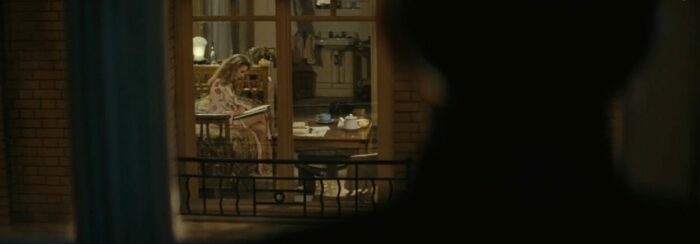“Nothing happens in your place that I am not in some way aware of,” says Monsieur Hire (Michel Blanc), looking steadily into the eyes of his beautiful neighbour across the courtyard, Alice (Sandrine Bonnaire). What is it about “peeping Tom”-themed films that fascinate us so? From Alfred Hitchcock’s Rear Window (1954) and Francis Ford Coppola’s The Conversation (1974) to Ferzan Özpetek’s Facing Windows (2003) and Florian Henckel von Donnersmarck’s The Lives of Others (2006), whether tuning in through a listening device or taking cover near a window, peering in, the situation of covertly zooming in on someone’s else private life on film, while the observing main character remains undiscovered, can produce a special kind of a thrilling story not untinged by creepiness. As this hidden main character in the story, will we, the audience, also get a glimpse of something that we should not see? It may just be that implicit secret complicity between the audience and the main character in these disturbing plot situations that fuels the intrigue further in this kind of film.
In the voyeurism-driven Monsieur Hire, which is based on a novella by Georges Simenon, French director Patrice Leconte introduces the titular character who becomes a prime suspect in a murder investigation of a recently deceased young woman. To say that Monsieur Hire is strange will be an understatement. Taciturn and socially-awkward, middle-aged Hire works as a tailor, but lives alone and spends his days watching his neighbour Alice through her window that just happens to be across Hire’s own apartment. His daily clandestine viewing of the woman may just be turning into an obsession he cannot hide for long. In the meantime, the investigation into the murder of the woman close to Hire’s apartment headed by one inspector (André Wilms) starts to uncover some damning evidence against the tailor. Is Alice, who remains oblivious to Hire’s attention, in danger? Monsieur Hire is both—an introspective crime mystery drama with erotic elements that subverts expectations, and an elegant cinematic examination of a tortured mind, loneliness, and desire for human connection.

French cinema is no stranger to showcasing oddball characters. One of the country’s most successful cinema exports, Jean-Pierre Jeunet’s film Amélie (2001), puts just such eccentricity at the very centre of its plot, and, previously, Jacques Tati’s outlandish films Playtime (1967) and Mon Oncle (1958) also had their share of success. This tradition continues somewhat with Monsieur Hire, but, this time, there is no humour or lovable goofiness found in the plot, and, instead, Leconte presents one unassuming, stern-looking character, veiling him in disturbing contours and melancholy spirit, and giving him strange habits (keeping mice) and unlikely talents (a penchant for bowling). In that vein, the main mystery in the film is not so much the crime investigated by Inspector, but the true character of Monsieur Hire. As Hire watches unsuspecting Alice through the window, we watch him; as he tries to guess the character of Alice, we, the audience, also try to guess who Hire really is and his motivations. Does he harbour dark intentions? Does he have a history of violence? Is he guilty of the murder of the young woman whose body was found near Alice and Hire’s apartment building? What will be the consequences of Hire’s incessant spying on Alice? The film’s true puzzle is not the crime, it is Monsieur Hire’s mind, and we, the audience, are the detectives.
The first thing to note in the film is that there is a contrast drawn between open, friendly and vivacious Alice and reclusive, silent and gloomy Monsieur Hire, but, perhaps more importantly, between polite, elegantly-dressed and effeminate-looking Monsieur Hire, on the one hand, and brazen, laddish and dandy Emile (Luc Thuillier), Alice’s boyfriend, on the other. And, even action-oriented, truth-seeking Investigator, who starts to pester Hire, provides a contrast which makes passive Monsieur Hire seem even more of an oddity in comparison. Simenon/Leconte may not have had in mind a full-blown battle between different kinds of masculinity in this story, but these three very different men circling around one female (and Alice may just fit into the role of a femme fatale) leave an impression, and the situation has distant echoes of another well-known French tale—Victor Hugo’s Notre-Dame de Paris (1831), where three very different in their social standing men: proper Archdeacon (Investigator), reckless Captain (Emile) and strange-looking-and-acting Quasimodo (Hire) all have different feelings for one friendly and carefree gypsy girl named Esmeralda (Alice), even if Investigator in Monsieur Hire has no amorous intentions regarding Alice.
However, Alice is also quite far from a film noir’s passive femme fatale, whose main task is usually to submit to the male gaze, in this case—quite literally. Far from being a passive “knife-throwing target object” of Leconte’s The Girl on the Bridge (1999), in Monsieur Hire, Alice is a person who actively seeks out the sources of her fascination, even if she does do the improbable—expresses immense curiosity and interest, rather than repulsion and fear, regarding Hire and his voyeuristic behaviour towards her. Having a handsome boyfriend, Alice’s relationship with awkward Hire seems very unlikely, but does it have some potential, anyway? Leconte unveils a male psyche faced with existential numbness, emotional inadequacy, as well as hopelessness and loneliness of the years to come, that kind that will also later emerge in full force and to a critical acclaim in Paolo Sorrentino’s best work, including The Consequences of Love (2004), The Great Beauty (2013) and Youth (2015). And, in playing with our expectations and setting the scene in Monsieur Hire, Leconte manages to inject an aura of dreamy unreality to many scenes, and seems to rescue the film from unnecessary melodrama by injecting moments of ambiguity (those white mice sequences) and unexpected subtlety (those close-up shots of forbidden passion), as well as by providing us with thought-provoking character insights.

Who are the observers of the observed? Do our observations of them correct? Do we, as some characters in this film, have prejudices or misconceptions that prevent us from seeing this picture clearly? All these questions arise in the film later on as Leconte initially shows us only what he wants us to see, providing plenty of clues and red herrings, seemingly following the advice of Alfred Hitchcock, who said that, to create true suspense, it is only necessary to give the audience enough right information at the very beginning. Michel Blanc (Tenue de soirée (1986)) as Hire and Sandrine Bonnaire (La Cérémonie (1995)) do a very fine job in their respective roles, and Denis Lenoir’s cinematography is intimately claustrophobic. Michael Nyman’s music also imbues the two main characters’ interactions with all the necessary emotion to enable Leconte create intimacy in the most unexpected of places, such as during a lively boxing match, and to heighten all the numerous sensory (including touch and smell) experiences in this film story.
Leconte has been accused of “objectifying the female body,” but Georges Simenon, the writer of the original source material of Monsieur Hire, has also been accused of misogyny, and that accusation fails to take into account Leconte’s burlesque, intentionally provocative tendencies in showing gender roles and various relationships between men and women. Amidst such potentially problematic aspects in films like Monsieur Hire and The Hairdresser’s Husband (1990), Leconte also made The Widow of Saint-Pierre (2000), a film which puts one woman (played by Juliette Binoche) on a pedestal, making her a stoic, strong and independent person who assumes control to champion a humanitarian goal against all odds, challenging the power and prejudice of men around her. In that way, much like Dutch film-maker Paul Verhoeven (RoboCop (1987), Elle (2016)), Leconte may be a director who is too complex and versatile and who evades strict categorisations, being never afraid to take on a disturbing material (such as The Suicide Shop (2012)) and make something meaningful from it. Monsieur Hire is just another example in the line of Leconte’s controversial films that unsettles, yes, but also intrigues and moves.
In today’s cinematic world where the mix of genres is lauded (for example, the works of the Daniels and Bong Joon-ho) and new sprouts of odd creativity are rewarded (for example, the works of Yorgos Lanthimos), perhaps what is in order is the re-examination and even re-appreciation of the often-misunderstood cinematic work of Patrice Leconte, who has played with different genres in his films, trying to distil his own hybrid style, sometimes in one single film. Like Leconte’s other work, Monsieur Hire primarily aims to challenge the viewer, offering a deeply psychological and sensual cinematic experience.



